NVIDIA GeForce GTX 780 Review: The New High End
by Ryan Smith on May 23, 2013 9:00 AM ESTCompute
Jumping into compute, we should see a mix of results here, with some tests favoring the GK110 based GTX 780’s more compute capable design, while other tests will punish it for not being a fast FP64 card like GTX Titan.
As always we'll start with our DirectCompute game example, Civilization V, which uses DirectCompute to decompress textures on the fly. Civ V includes a sub-benchmark that exclusively tests the speed of their texture decompression algorithm by repeatedly decompressing the textures required for one of the game’s leader scenes. While DirectCompute is used in many games, this is one of the only games with a benchmark that can isolate the use of DirectCompute and its resulting performance.
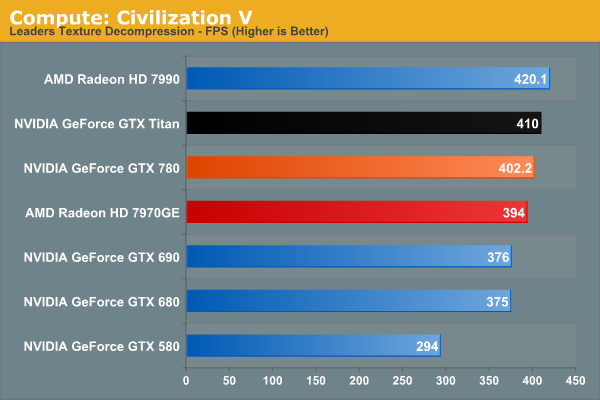
Civilization V’s DirectCompute performance is looking increasingly maxed out at the high end. At 402fps the GTX 780 may as well be tied with GTX Titan. On the other hand it’s a reminder that while we don’t always see NVIDIA do well in our more pure compute tests, it can deliver where it matters for games with DirectCompute.
Our next benchmark is LuxMark2.0, the official benchmark of SmallLuxGPU 2.0. SmallLuxGPU is an OpenCL accelerated ray tracer that is part of the larger LuxRender suite. Ray tracing has become a stronghold for GPUs in recent years as ray tracing maps well to GPU pipelines, allowing artists to render scenes much more quickly than with CPUs alone.
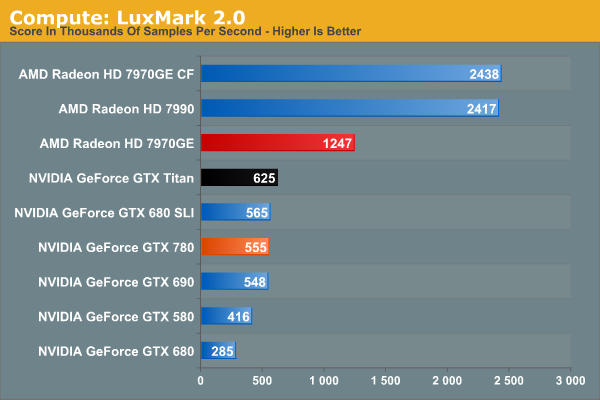
NVIDIA has never done well at LuxMark, and GTX 780 won’t change that. It’s greatly faster than GTX 680 and that’s about it. Kepler parts, including GK110, continue to have trouble with our OpenCL benchmarks, as evidenced by the fact that GTX 780 doesn’t beat GTX 580 by nearly as much as the generational improvements should lead to. GK110 is a strong compute GPU, but not in ways that LuxMark is going to benefit.
Our 3rd benchmark set comes from CLBenchmark 1.1. CLBenchmark contains a number of subtests; we’re focusing on the most practical of them, the computer vision test and the fluid simulation test. The former being a useful proxy for computer imaging tasks where systems are required to parse images and identify features (e.g. humans), while fluid simulations are common in professional graphics work and games alike.
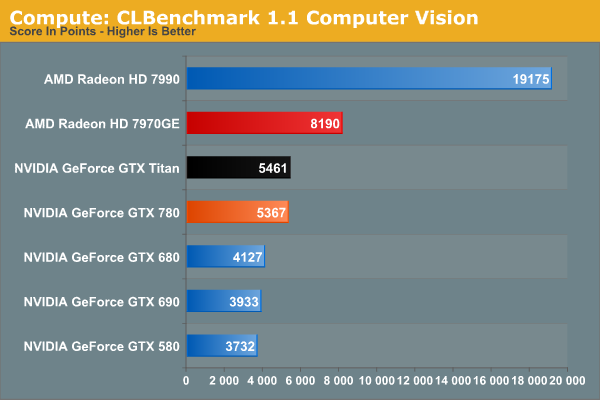
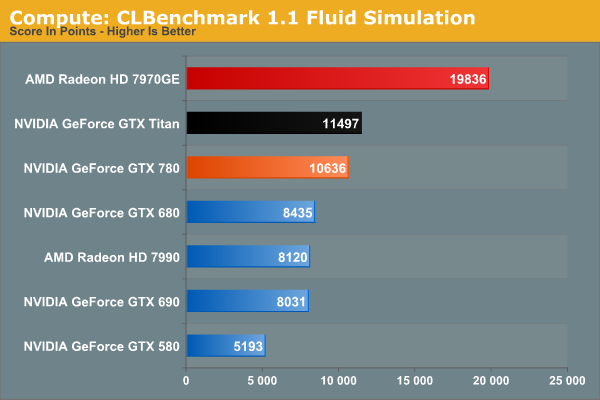
GTX 780 still struggles some at compute with CLBenchmark, but less so than with LuxMark. 7970GE is the clear winner here in both tests, while GTX 780 stays remarkably close to GTX Titan in performance. The fluid simulation in particular makes GTX 780 look good on a generational basis, more than doubling GTX 580’s performance.
Moving on, our 4th compute benchmark is FAHBench, the official Folding @ Home benchmark. Folding @ Home is the popular Stanford-backed research and distributed computing initiative that has work distributed to millions of volunteer computers over the internet, each of which is responsible for a tiny slice of a protein folding simulation. FAHBench can test both single precision and double precision floating point performance, with single precision being the most useful metric for most consumer cards due to their low double precision performance. Each precision has two modes, explicit and implicit, the difference being whether water atoms are included in the simulation, which adds quite a bit of work and overhead. This is another OpenCL test, as Folding @ Home has moved exclusively to OpenCL this year with FAHCore 17.

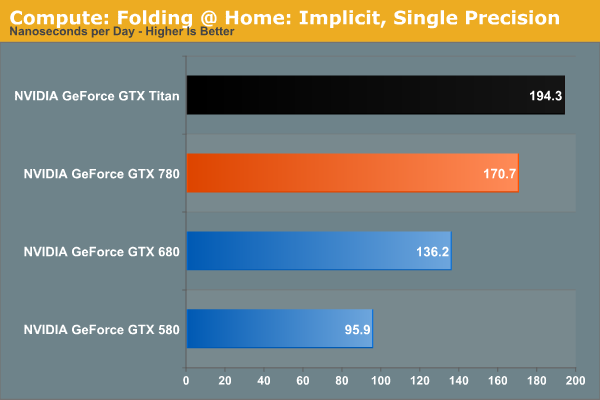
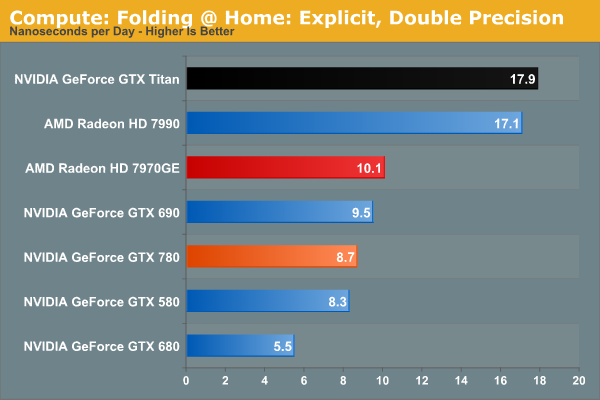
The Folding@Home group recently pushed out a major core update(FAHBench 1.2.0), which we’ve rerun on a number of cards and is reflected in our results. Unfortunately this version also broke single precision implicit on AMD GPUs and AMD’s latest drivers, so we only have NVIDIA GPUs for that section.
In any case, despite the fact that this is an OpenCL benchmark this is one of the cases where NVIDIA GPUs do well enough for themselves in single precision mode, with GTX 780 surpassing 7970GE, and falling behind only GTX Titan and the 7990. GTX 780 doesn’t necessarily benefit from GK110’s extra compute functionality, but it does see a performance improvement over GTX 680 that’s close to the theoretical difference in shader performance. Meanwhile in double precision mode, the lack of an uncapped double precision mode for GTX 780 means that it brings up the bottom of the charts compared to Titan and its 1/3 FP64 rate. Compute customers looking for a bargain NVIDIA card (relatively speaking) will need to stick with Titan.
Wrapping things up, our final compute benchmark is an in-house project developed by our very own Dr. Ian Cutress. SystemCompute is our first C++ AMP benchmark, utilizing Microsoft’s simple C++ extensions to allow the easy use of GPU computing in C++ programs. SystemCompute in turn is a collection of benchmarks for several different fundamental compute algorithms, as described in this previous article, with the final score represented in points. DirectCompute is the compute backend for C++ AMP on Windows, so this forms our other DirectCompute test.
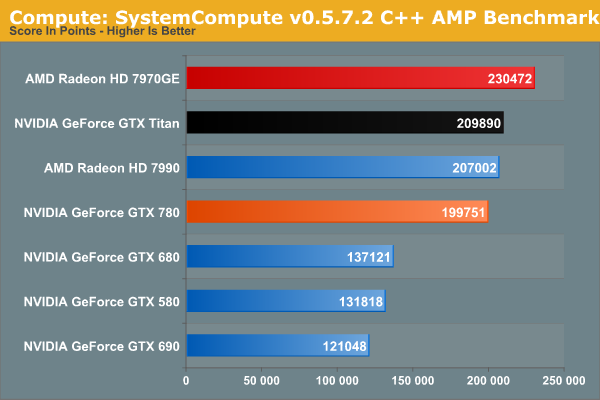
SystemCompute shows very clear gains over both the GTX 680 and GTX 580, while trailing the GTX Titan as expected. However like Titan, both trail the 7970GE.










155 Comments
View All Comments
aidivn - Thursday, May 23, 2013 - link
so, how many Double Precision units are there in each SMX unit of gtx780? titan had 64 dp units in each of their SMX units which totaled to 896 dp unitsAnd can u turn them on or off from the forcewre driver menu like “CUDA – Double Precision” for gtx780?
Ryan Smith - Thursday, May 23, 2013 - link
Hardware wise this is GK110, so the 64 DP units are there. But most of them would be disabled to get the 1/24 FP64 rate.aidivn - Friday, May 24, 2013 - link
so how many are disabled and how many are enabled (numbers please)?Ryan Smith - Friday, May 24, 2013 - link
You would have only 1/8th enabled. So 8 per SMX are enabled, while the other 56 are disabled.aidivn - Saturday, May 25, 2013 - link
so, the GTX780 only has 96 DP units enabled while the GTX TITAN has 896 DP units enabled...thats a huge cut on double precisionDanNeely - Sunday, May 26, 2013 - link
That surprised me too. Previously the cards based on the G*100/110 cards were 1/8; this is a major hit vs the 580/480/280 series cards.Old_Fogie_Late_Bloomer - Thursday, May 23, 2013 - link
"GTX 780 on the other hand is a pure gaming/consumer part like the rest of the GeForce lineup, meaning NVIDIA has stripped it of Titan’s marquee compute feature: uncapped double precision (FP64) performance. As a result GTX 780 can offer 90% of GTX Titan’s gaming performance, but it can only offer a fraction of GTX Titan’s FP64 compute performance, topping out at 1/24th FP32 performance rather than 1/3rd like Titan."Seriously, this is just...it's asinine. Utterly asinine.
tipoo - Thursday, May 23, 2013 - link
Market segmentation is nothing new. The Titan really is a steal if you need DP, the next card up is 2400 dollars.Old_Fogie_Late_Bloomer - Thursday, May 23, 2013 - link
I'm well aware of the existence of market segmentation, but this is just ridiculous. Putting ECC RAM on professional cards is segmentation. Disabling otherwise functional features of hardware, most likely in the software drivers...that's just...ugh.SymphonyX7 - Thursday, May 23, 2013 - link
I just noticed that the Radeon HD 7970 Ghz Edition has been trouncing the GTX 680 in most of the benchmarks and trailing the GTX 680 in those benchmarks that traditionally favored Kepler. What the heck just happened? Didn't the review of the Radeon HD 7970 Ghz Edition say that it was basically tied with the GTX 680?